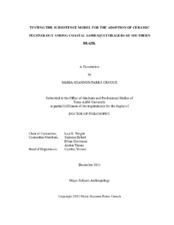| dc.contributor.advisor | Wright, Lori E | |
| dc.creator | Crouch, Maria Shannon Parks | |
| dc.date.accessioned | 2014-05-13T17:27:32Z | |
| dc.date.available | 2015-12-01T06:31:11Z | |
| dc.date.created | 2013-12 | |
| dc.date.issued | 2013-12-10 | |
| dc.date.submitted | December 2013 | |
| dc.identifier.uri | https://hdl.handle.net/1969.1/151867 | |
| dc.description.abstract | This research tests the subsistence model for the adoption of ceramic technology among coastal fisher-hunter-gatherers of the southern Atlantic coast of Brazil (5000 to 600 BP). The subsistence model correlates the appearance of ceramic vessels at coastal sambaqui (shell mound) sites with changes in diet and/or food processing techniques. An alternative model, the prestige model, argues that prehistoric populations initially use pottery as status-bearing items in competitive feasting or as serving vessels for elite group members. To test the subsistence model, I conducted a stable carbon and nitrogen isotope analysis and a dental microwear texture analysis using skeletal remains from sambaqui sites located in Santa Catarina and Rio de Janeiro, Brazil.
The results of the stable carbon isotope analysis indicate no significant difference between Pre-Ceramic and Ceramic occupations when all individuals were considered. However, when only sexed individuals were considered, males of the Pre-Ceramic period show greater consumption of marine foods than Pre-Ceramic occupation females. This difference between males and females is not significant for the Ceramic period. Results of the nitrogen isotope analysis indicate a significant increase in the consumption of marine foods among all individuals during the Ceramic period compared to the Pre-Ceramic period.
The results of the dental microwear texture analysis indicate no significant difference between the Pre-Ceramic and Ceramic periods when all individuals were considered. However, Pre-Ceramic occupation males show significantly greater tooth enamel complexity (Asfc) than males of the Ceramic period. I found no statistically significant differences between time periods for anisotropy (epLsar); however, a plot containing epLsar measurements and nitrogen isotope ratios reveals a relationship between the data. Individuals from the Ceramic period tend to plot lower for measurements of anisotropy and higher for marine food consumption, while Pre-Ceramic occupation individuals plot higher for anisotropy and lower for marine food consumption.
This study partially supports the subsistence model for the adoption of ceramic technology at sambaqui sites, as tests show significant differences based on sex. However, there is room in the data to explore ideas related to changes in social and political organization with the arrival of ceramic technology at these sites. | en |
| dc.format.mimetype | application/pdf | |
| dc.language.iso | en | |
| dc.subject | carbon and nitrogen isotope analysis | en |
| dc.subject | dental microwear texture analysis | en |
| dc.subject | coastal foragers | en |
| dc.subject | complex hunter-gatherers | en |
| dc.subject | Brazilian archaeology | en |
| dc.title | Testing the Subsistence Model for the Adoption of Ceramic Technology Among Coastal Sambaqui Foragers of Southern Brazil | en |
| dc.type | Thesis | en |
| thesis.degree.department | Anthropology | en |
| thesis.degree.discipline | Anthropology | en |
| thesis.degree.grantor | Texas A & M University | en |
| thesis.degree.name | Doctor of Philosophy | en |
| thesis.degree.level | Doctoral | en |
| dc.contributor.committeeMember | Grossman, Ethan | |
| dc.contributor.committeeMember | Thoms, Alston | |
| dc.contributor.committeeMember | Eckert, Suzanne | |
| dc.type.material | text | en |
| dc.date.updated | 2014-05-13T17:27:32Z | |
| local.embargo.terms | 2015-12-01 | |


